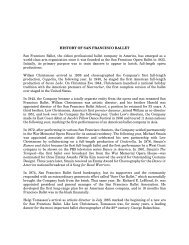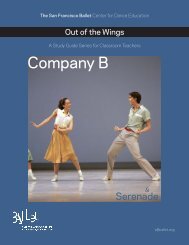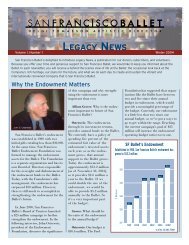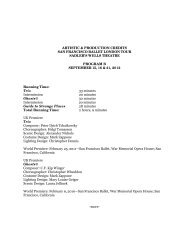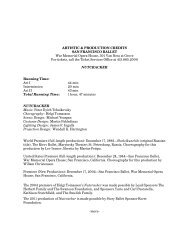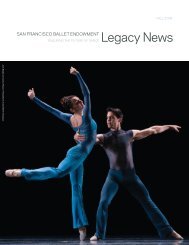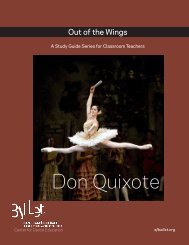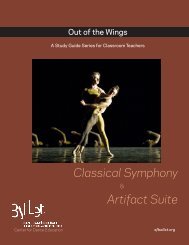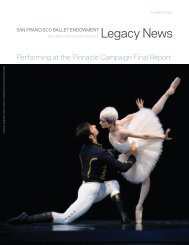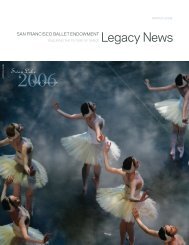Artistic & Production Credits - San Francisco Ballet
Artistic & Production Credits - San Francisco Ballet
Artistic & Production Credits - San Francisco Ballet
Create successful ePaper yourself
Turn your PDF publications into a flip-book with our unique Google optimized e-Paper software.
MICHEL FOKINE<br />
CHOREOGRAPHER<br />
Michel Fokine was born on April 25, 1880 in St. Petersburg, Russia, the seventeenth of eighteen<br />
children. In 1889 Fokine entered the selective Imperial School of <strong>Ballet</strong> at St. Petersburg where<br />
dance instruction was intense and academic subjects secondary. Upon graduating in 1898<br />
Fokine joined the Maryinsky Imperial <strong>Ballet</strong> at St. Petersburg, the home of opera and ballet in<br />
Russia, as a soloist, and began dancing with the famous Anna Pavlova. Hired in 1902 to teach the<br />
girls junior class, he became the youngest faculty member ever.<br />
The first two years at the Maryinsky were depressing for Fokine and he considered abandoning<br />
ballet. He believed that ballet at that time was too absorbed with technique and gymnastics<br />
execution and that there was too much emphasis on the legs. He also did not approve of always<br />
using ready–made dance steps, short skirts, and pink dancing shoes. Michel thought the timeperiod<br />
and character of the nation represented should be researched and reflected in the dance,<br />
and that the troupe of dancers should be used for expression and not just ornamentation. This<br />
philosophy was summed up in his “Five Principles” as explained in a letter to the London Times<br />
on July 6, 1914. These principles revolutionized ballet and were applied to his creations during<br />
the early 1900’s, performed at the Maryinsky Imperial <strong>Ballet</strong> and, under Serge Diaghilev, at the<br />
<strong>Ballet</strong>s Russes. They include: The Dying Swan, Le Vigne, Le Pavilion d’armide, Les Sylphides,<br />
Prince Igor, Cleopatra, Carnaval, Firebird, Scheherazade, Le Spectre de la rose, Petrouchka,<br />
Daphnis and Chloe and Le Coq d’or.<br />
In 1905 Anna Pavlova, the great Russian ballerina, came to Fokine and asked him to suggest<br />
some music for her to dance to in the Hall of Nobles. At the time he was playing Camille Saint-<br />
Saëns The Swan at home on the mandolin and choreographed a ballet to it in a matter of<br />
minutes. That ballet remained in Pavlova’s repertory for the rest of her life. Her dying statement<br />
on August 23, 1931 was “Prepare my Swan costume.” Pavlova appeared in many of Fokine’s early<br />
ballets as did the dancer Vaslav Nijinsky. In 1905 Fokine married one of his students, Verotchka<br />
(Vera) Antonova, and they would later have a son, Vitale. When creating the ballets Firebird and<br />
Petrouchka, Fokine collaborated with Igor Stravinsky and with Maurice Ravel for Daphnis and<br />
Chloe. He also worked closely with Serge Rachmaninoff to present Paganini in 1939.<br />
The Bolshevik Revolution caused the Fokines to move from Russia in 1918 and in 1919 they came<br />
to the United States, having been contracted by Morris Gest to stage the Bacchanal in Aphrodite.<br />
Very few ballet schools existed outside of New York City and for Aphrodite the Fokines used<br />
semi–amateur ballet dancers and ballroom dancers.<br />
In the 1920’s the Fokines toured many of the largest cities in the United States and Michel did<br />
work on and off Broadway. He choreographed musical numbers for the Ziegfeld Follies, among<br />
-more-




